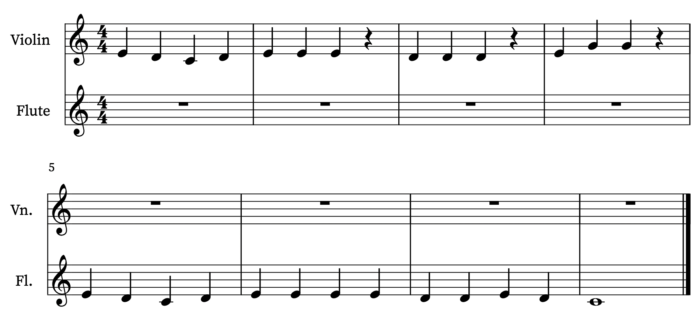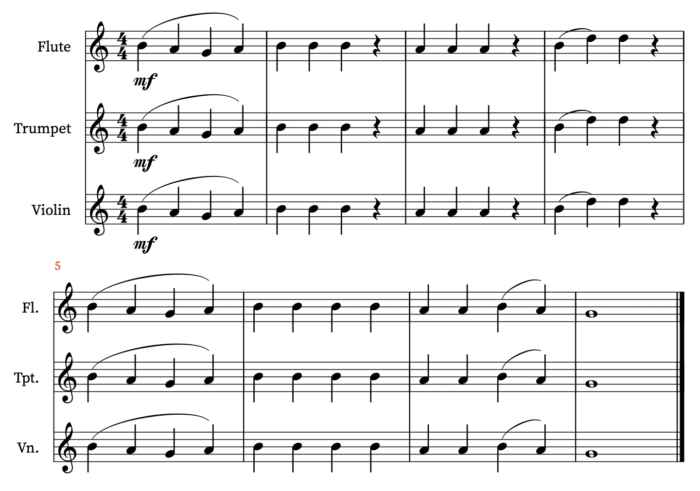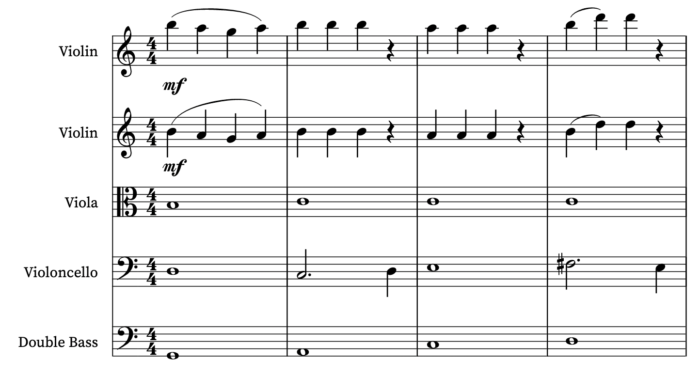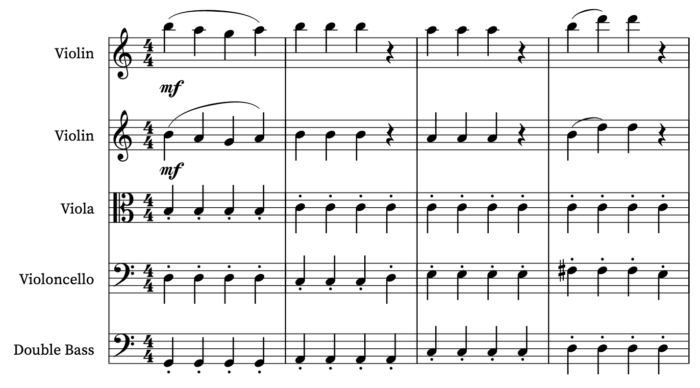Instrumental variations
October 30, 2021The other day I was following along with the score for the “Academic Festival Overture” by Johannes Brahms and noticed that often the same musical material was repeated, but played by different instruments. It’s often something that orchestral composers (classical composers as well as film composers and jazz composers) will do to keep the song interesting and exciting without having to constantly create more new musical material.
Creating new musical material might not be the sound you want. It can often create a piece of music that has too many ideas that never get fully developed or finished. So one way to keep a song or piece of music interesting is by re-using musical material and developing that musical material by changing the arrangement or using different instruments to play the same musical ideas.
Here are some ways that you can use this and similar compositional techniques in your own writing to improve your compositional skills.
- Vary the instruments
- Switch instruments mid melody
- Change the combination of instruments
- Change the register
- Use different techniques or articulations
- Vary the arrangement
Let’s start from the top.
Vary the instruments
This is possibly the most common way of adding some variation to orchestral music and electronic music, though those two genres may not be similar in the instruments that they use, they are similar in how they use this technique.
If you listen to classical music you’ll likely be familiar with how this sounds because it’s so common. This is done by playing one melody multiple times, but each time it’s played a different instrument plays the melody. Film music also does this quite often. I’ve been listening to the Luca Soundtrack recently and if you listen to that soundtrack you’ll often here one theme being thrown around to different instruments.
For example in the song “Vespa è Libertà” the melody original starts in a type of flute-like woodwind instrument, maybe an ocarina or a recorder or someone whistling. Later, a part of that same theme is played by the bassoon. And throughout the movie that theme comes back played by violins.
Sections in between these two can be written to add some extra variation. Or you can change the arrangement underneath each of these sections. But changing what instrument is playing the melody can allow you to use the same melodies and material without it sounding too repetitive and getting stale.
Switch instruments mid melody
In the middle of the melody switch what instrument is playing. Pass the melody around to different instruments as it plays.
This technique can take a little bit of practice and fiddling because just simply passing it around without looking at phrases can sound awkward.
There are a few things we can do to get past this. You can switch instruments in the middle of the melody, right after a rest, or a pause in the phrase. Below is an example of this using the song “Mary Had a Little Lamb” played by flute and violin.

Notice that the violin has the melody for the first four bars, and then the flute plays the last four bars of the melody. This way they don’t interfere with each other and we hear a whole phrase played by one instrument. This is definitely one way to write melodies between instruments and ensure that it will sound like a natural and smooth transition from one instrument to another.
But we can also switch what instrument is playing the melody within a phrase, though that does need to be done with a little more care. Below is another example of flute and violin playing “Mary Had a Little Lamb”, but this time they switch earlier in the phrase.

Notice that they switch mid phrase, but there is a rest in the second measure right before we hear the switch. Also notice that in measure 7 the melody is dovetailed. This is the technique of trading something from one instrument to another smoothy by adding one or two notes as a transition. Rather than simply having the flute pick up the melody in measure 7, I added the first note of the melody to the violin part. That way there will be a smooth transition to the new instrument, flute. It’s also a strong beat, so when we add that one note we’ll be passing the melody off and ending it on the violin part. It’ll make it a slightly smoother transition from one instrument to the next.
One other reason for why this creates a smoother transition is that we hear both instruments together. Before the transition we’re hearing just the violin playing the melody. On the first beat of measure 7 we’re hearing, for just a brief moment, both the violin and flute playing the melody. Then after that beat we hear just the flute playing the melody. There’s actually a transition. If we didn’t add that one beat in the violins there wouldn’t be any transition. We would just go straight from hearing violin to hearing flute.
Something to remember when using this technique is that you almost always want to dovetail when you’re doing this.
I learned this the hard way by writing a piece of music, that ended up being performed by the Boston Philharmonic Youth Orchestra. I had a phrase being passed between the first flute and second flute and I notated this in the parts and the score, but I didn’t dovetail. As soon as they started playing, one of my composition teachers, and the conductor, mentioned that as a way to improve the piece and my writing because that was the idea I wanted to write. I just didn’t know what that compositional technique was.
Once they described it, I knew that’s what I meant to write, but I didn’t realize that what I wrote wasn’t that technique. It was infuriating because it’d improve the sound of that section a whole lot and create a much smoother sound. But that’s what happens when you’re learning to write for orchestra.
The recording still ended up being great, but that would’ve made it sound just a little bit smoother and more natural of an idea.
Let’s get to the next technique.
Change the combination of instruments
In addition to switching instruments we can also add some variation to our music by changing the combination of instruments. For example if the melody is being played by violin, flute, and trumpet, the next time the same melody is played it could be played by viola, oboe, and french horn. Even if it is played in the same register it will sound a little bit more fresh because the timbre of the instruments is different.
Notice that we also kept the number of instruments the same and used one from each family. We had one woodwind, one brass, and one string instrument. The first combination had flute as the woodwind instrument, trumpet as the brass instrument and violin as the string instrument.
Below is a concert score example of this so that you can see what this might look like.

The next combination of instruments had oboe as the woodwind instrument, french horn as the brass instrument, and viola as the string instrument.
Below is a concert score example of how this might look.

These two examples are fairly similar, but depending on how different you want it to sound, you can choose different instruments. If you want a bigger contrast in sound then you could use instruments from completely different families, or all one family, or a mix.
There’s so many different combinations of instruments that you can put together to create different sounds. This can even include instruments playing in unison, or playing solo. The sound of one French Horn playing a melody is different than the sound of four French Horns playing the melody all together. The same is true for violins. You could write a violin or cello solo for the concert master or first chair cello player, to contrast with the whole violin or cello section playing that same melody.
There are tons of different combinations of instruments and it’d be impossible to go through all of them and explain all of the different ways of combining timbres.
Change the register
Changing the register of the instruments can also be a great way to keep the melody sounding fresh. This may not always be the choice you want for your music because it does have a different sound than keeping it in the same register, but it’s another tool to use.
Maybe the melody starts out in the violins and then switches to the cellos later and is played lower in register.
Those two instruments sound similar because they’re both string instruments, but having the melody played lower in the cello will require a different arrangement than having the melody played up high in the violins.


These two melodies are the same articulations, dynamics, notes, and rhythms, but they’ll have two different sounds because they’re in different registers and different instruments.
When doing this, remember to adjust the arrangement around the melody so that there is space in the lower register for the melody to come through. You want to leave space and make sure no other instrument is using those same notes so that the melody can be heard. Because the example we used was cello we could still have a bass playing some type of bass notes, but anything else in that register would muddy up the sound and make it hard to hear that melody in the cellos.
This literally means leaving space in the music. If you were to play the entire thing on piano, make sure that no other instrument is playing those notes on the piano. That way the melody will be able to be heard clearly.
Use different techniques or articulations
One other way to change up the melody and add some variation with instruments is to use different techniques on the same instrument.
In the strings this might mean adding a mute or taking away a mute. It could also mean playing sul tasto or sul ponticello. It could mean playing the melody pizzicato, using your fingers, as opposed to arco, using the bow.
In the brass it could be using a mute or using a technique like flutter tonguing.
In the woodwinds it could mean using flutter tonguing or over blowing or some other technique.
Another way to change the sound of a melody played by one instrument is to change the melody from staccato to legato. In one part of the music you might want the melody to be played staccato and in another you might want it to be played legato. Adding different articulations to a melody can create a slightly altered version that sounds fresh when played because it’s the same notes, but different articulations.
Something about the melody is changed and that can add some extra variation to it to keep it from getting stale.
Below are two different examples of this. The one below is mostly legato.

The example below is mostly staccato.

They’re not completely different music, but these are two different ways to change up how the part will sound to create a more interesting arrangement.
In addition to these, there are many other different ways of writing articulations into the same piece of music to create multiple different versions.
Vary the arrangement
One final way to keep a melody sounding fresh is to change the arrangement underneath the melody. If the melody is being played over whole notes, change those to staccato quarter notes and that will sound quite different.
Below is an example of how this might look with mostly whole notes, and the melody in octaves in the first and second violins. I added in some dotted half notes and quarter notes in the cello to add some interest and keep the lines step-wise in motion.

Below is the same arrangement with all quarter notes that are staccato.

These two arrangements will sound very different, but the notes are basically the same.
This can be used as one way to create a different version of the same themes and harmonies so that you can use the same material multiple times and keep it fresh. It’s especially useful when writing larger forms of music like symphonies or tone poems.
It’s also great when writing music for film because doing this can help you more easily create multiple arrangements of one melody to be used at different points in the film. Depending on what’s going on in the film you’ll want to have different emotions conveyed in the music. In some parts of the film you’ll want to have long, mostly whole notes and in other parts of the film you’ll want to have staccato quarter notes.
Final notes
When writing for an ensemble it can be tempting to write everything the way you would if you were simply composing notes on a page. But you’re not just writing notes on a page and writing specifically for the instruments that will be playing the music will create a much more interesting arrangement. Part of this means writing in a way that they will be used to, but it also means writing in a way that uses those instruments fully. If musicians are showing up to play your music make it worth their while. Make sure what you write for them has a purpose and an intention behind it. Each note should be necessary and needed in order to convey whatever emotion, feeling, or idea that you want to convey.
I also think this is another reason to vary your music and keep the arrangement interesting, even if you are repeating musical material. Just because you have repeated material, doesn’t mean that everything needs to be written exactly the same. Rather than writing a repeat sign, create a second arrangement of the music that’s slightly different and that will keep the ideas sounding fresh.
It’s also easier to play. As a musician it’s so much easier to play a piece of music that stays fresh the entire time, rather than a piece of music that only repeats exactly the same way multiple times. It’s easy to get lost in the music when you’re just playing the same thing over and over and counting the number of times you’ve played it. It might take some more work, as a player, to play an arrangement that’s not always the same, but it’s easier to follow.
This can seem like a lot to think about, and at first it certainly is, but eventually the more you do it the easier it gets and the faster you get at doing it. The more music you write for string quartets, the better you’ll get at writing string quartets. The more you write music for orchestra, the better you get at writing music for orchestra. I wouldn’t recommend just writing tons and tons of music, though that can definitely be useful, but write lots of music and look at and listen to lots of music. The more music you listen to and learn about and understand, the better you’ll be able to incorporate those ideas into your own writing.
Give these ideas a shot. I suggest you take one idea and write a short 3 minute piece or 3 minute arrangement that uses that idea and try to explore what you can do with that idea. Then move on to another one of these ideas. It can be useful to focus on one single idea without overwhelming yourself by trying to learn six different compositional techniques at the same time.
ISJ